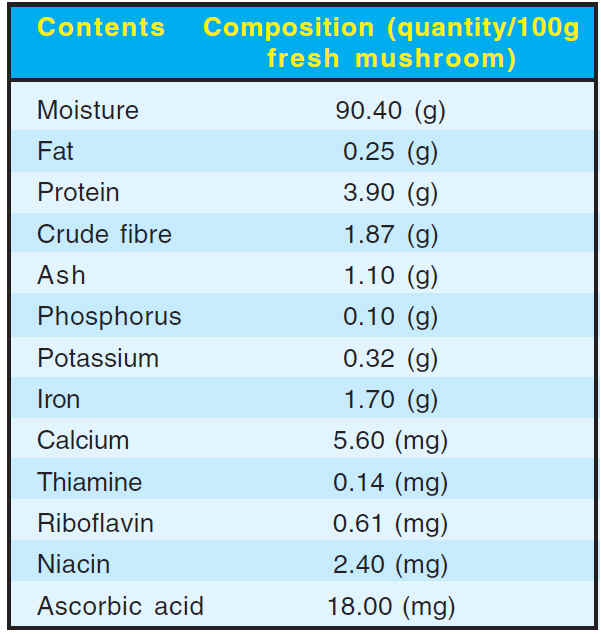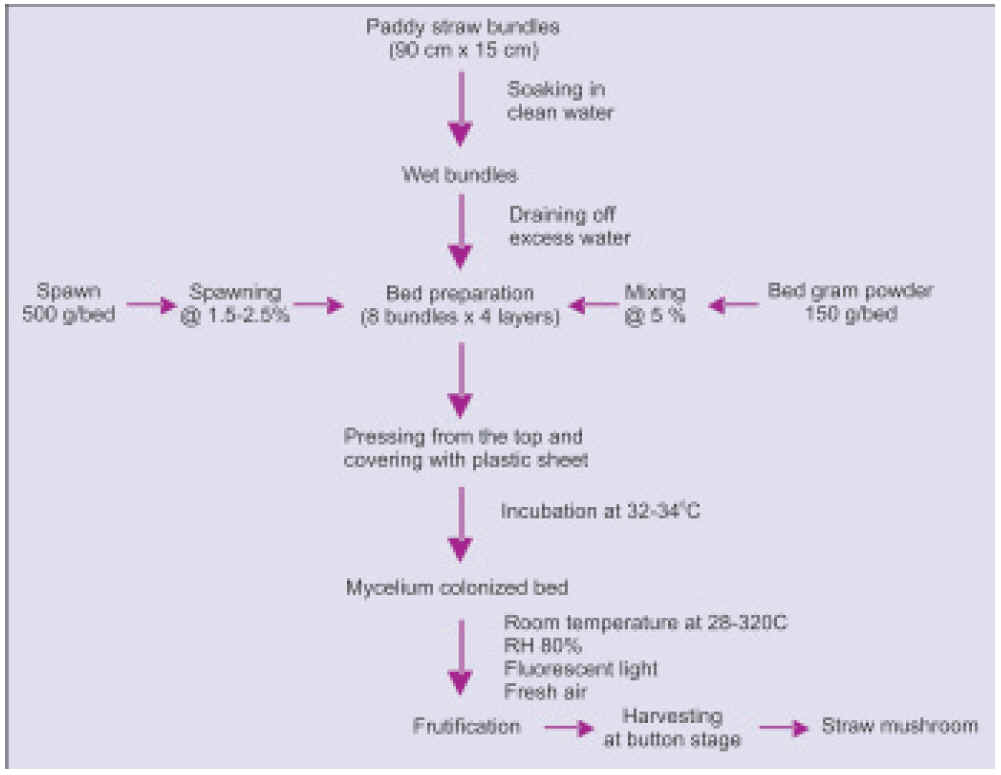Paddy straw mushroom is an edible mushroom of the tropics and
subtropics. It was first cultivated in China as early as in 1822. Around
1932-35, the straw mushroom was introduced into Philippines, Malaysia, and other
South-East Asian countries by overseas Chinese. In India this mushroom was first
cultivated in early 1940’s. In India 19 edible species of Volvariella have
been recorded but cultivation methods have been devised for three of them only
viz; V. esculenta (Mass) Sing., V. diplasia (Berk and Br.) Sing. and V.volvacea
(Bull. ex Fr.) Sing. The optimum temperature and moisture for the growth of this
mushroom are 35°Cand 57-60%, respectively. It can be cultivated in North-Indian
plains from July to September and in peninsular India from March to November.
However, in the hilly areas during the November to January months artificial
heating is necessary to raise the environmental and bed temperature but in the
plains, artificial heating can be minimized by the incorporation of Melia
azadirachta indica and Tamarindus indicus leaves in alternate layers.
A. Morphological Characteristics


Fig. 1. Different
structure of V. Volvacea fruiting
body Table
1. Proximate
composition of paddy straw
mushroom
This genus takes its name from ‘Volva’means a wrapper; which
completely envelops the main fruit body during the young stage. The fruit body
formation starts with distinct tiny clusters of white hyphal aggregates called
primordia and is followed by successive stages named as ‘button’, egg’,
‘elongation’ and ‘mature’. Differentiation can be seen first at the ‘button’
stage. At maturity, the buttons enlarge and umbrella like fruiting bodies emerge
after the rupture of the volva. The mature fruiting body can be distinguished
into the following structures (Fig. 17.1).
Volva:
The universal veil is known as volva and it remains more or less distinct in the
adult mushroom as a cup like structure at the base of the stipe.
Stipe:
Off-white to dull brown in colour, long, round with a smooth surface and no
annulus. The stipe enlarges slightly to a bulbous base, which is encased with a
distinct membraneous volva.
Pileus:
The umbrella like fleshy structure attached to the stipe. The size of the pileus
is affected by environmental factors, but generally it is around 5-15 cm broad.
The ‘annulus’ or ring like structure on the stipe is conspicuously absent in
this mushroom.
Gills:
The vertical, radial plates on the lower surface of the pileus are lamellae or
gills. All gills are with entire margin and fimbriate edges, but the size varies
from one quarter of the radius of the pileus to the full size. The top surface
of the cap is soft and smooth in texture. The colour of the fully-grown pileus
is greyish white with a reddish tinge. The grey being dominant in the centre of
the cap. The stipe of the umbrella tapers from the base to the apex and is
solid, smooth and white in colour. The stipe is easily separable from the pileus
at its junction. The gills are also free from stipe. The pileus is initially
well shaped but later becomes convex to umbonate.
B. Nutritive Value
The excellent unique flavour and textural characteristics
distinguish this mushroom from other edible mushrooms. The nutritive value of
paddy straw mushroom is affected by the method of cropping and the stages of
maturation. The proximate composition of paddy straw mushroom is given in Table
17.1. Available data reveal that on fresh weight basis it contains around 90%
water, 30-43% crude protein, 1-6% fat, 12-48% carbohydrates, 4-10% crude fibre
and 5.13% ash. The fat content increases with the maturation stage and the fully
mature fruit body contains as high as 5% fat. The N-free carbohydrates increases
from button to the egg stage, remains constant at the elongation and drops at
the mature stage. The crude fibre remains at almost same level
in first three stages and increases at mature stage. The egg stage contains
highest level of protein, which decreases at mature stage. Ash content remains
almost similar at all the developmental stages. The straw mushroom is known to
be rich in minerals such as potassium, sodium and phosphorus. Potassium
constitutes the major fraction of the major elements, followed by sodium and
calcium. The levels of K, Ca and Mg remain almost same at different
developmental stages, except that of Na and P, which drops at elongation and at
mature stages. The contents of minor elements namely Cu, Zn and Fe did not vary
much at different stages of development.
The levels of thiamin and riboflavin in paddy straw mushroom are
lower than Agaricus bisporus and Lentinula edodes, while niacin is at par with
these two mushrooms. At all the stages lysine is the most abundant essential
amino acid and glutamic acid and aspartic acid are the most abundant
non-essential amino acids (Table 17.2). Tryptophan and methionine are lowest
among essential amino acids. The level of phenylalanine increases nearly one
fold at elongation stage, while lysine decreases to about half of its value at
the button stage. The straw mushroom is comparable to that of the other
mushrooms both in terms of amino acid composition and the percentage of
essential amino acids in the total amino acids. In fact, paddy straw mushroom
contains high percentage of essential amino acids in comparison to other
mushroom and the abundance of lysine is very important. The other three amino
acids namely leucine, isoleucine and methionine are low in paddy straw
mushrooms.
C. Cultivation
1. Conventional method
-
Different
steps involved in this method are as follows (Fig. .2)
-
Preparation
of paddy straw bundles of 0.75 – 1.0 kg (80-95 cm long & 12-15 cm
wide) preferably from hand threshed paddy.
-
Immersing
the bundles in clean water for 12-18 hours in a cemented water tank.
-
Draining
out of excess water by placing bundles on raised bamboo or cemented
platform.
-
Making
bed by placing 4 bundles side by side and another four bundles similarly but
from the opposite side forming one layer of eight bundles.
-
Preparation
of second, third and fourth layer by intermittent spawning between first and
second, second and third and third and fourth layers.
-
Spawning
the entire surface of different layers of the beds leaving margin of 12-
-
15 cm
from edges at a space of 5 cm apart.
-
Sprinkling
red gram powder over the spawned surface.
-
Using
500 gm spawn and 150 g of red gram powder for a bed of 30-40 kg paddy straw.
-
Pressing
the bed from the top and covering with clean polythene sheet for maintaining
required humidity (80-85%) and temperature (30-35°C).
-
Removal
of polythene sheet after 7-8 days and maintain a temperature of 28-32°C
with 80% humidity.
-
Mushroom
will start appearing after 4-5 days after the sheet is removed and will
continue for next 20 days.
-
After crop harvest the
left over substrate can be converted into manure for its use in the fields.


Table 2. Amino
acid contents of paddy straw mushroom
Fig. 2. Conventional
method of paddy straw mushroom cultivation
Note
-
For hot
regions the width of bed can be decreased by placing first layer of 4
bundles followed by another layer of 4 bundles from opposite side but
directly on the first layer. It is to be followed by 3rd, 4th and 5th
layers. The 5th layer can be of bundles or of loosened paddy straw.
-
The size of
beds may vary from 100 x 100 x 100 cm; 60 x 60 x 30 cm; 60 x 60 x 120 cm.
-
Alternatively
the beds can be prepared with the help of boxes of 80x80x10 cm and 60x40x30
cm size. In this method the material is to be chopped to a uniform length of
20cm followed by filling in box parallel to length of the box. It is
followed by soaking of the material along with box in 2% CaCo3 solution for
2 hrs or until the straw becomes dark brown. It is followed by draining of
excess water and spawning the substrate at a depth of 5 cm from the sides of
the box, followed by plugging the openings with previously water soaked
newsprint. The boxes are to be incubated at a temperature of 35 to 38°C
with RH of 75% for next 4-5 days, followed by lowering of temperature to 28
to 30°C with 75 to 85% RH along with introduction of fresh air. Use of
superfine mist is recommended for maintaining humidity in the room. Spray
fine mist of water if drying of beds is noticed,further for good harvest
maintain proper aeration, temperature and humidity. This can be best
achieved by controlling the ventilation/AHU’s.
2. Improved cage cultivation (Fig.
.3)
a. Material required
1. Paddy straw
bundles 60/Cage
2. Spawn
bottle
2/Cage

Fig. 3. Cage cultivation
3. Wooden
cage
1 No. (1 m x 50 cm x 25 cm)
4. Drum 1
No.
(100 liters cap.)
5. Polythene
sheet
4 meters
6. Binding
thread
3 meters
7. Sprayer/Rose
can
1 No.
8. Dithane
Z-78/Bavistin 1 Pkt. (250 g)
9.
Malathion
1 bottle (250 ml)
10.
Dettol/Formalin
1 bottle (1/2 liter)
11. Dao (Hand
chopper) 1 No.
12.
Thermometer
1 No.
b. Methodology

Fig. .4. Stages
of paddy straw
mushroom cultivation
|
Select dry, fresh and hand-threshed paddy straw free from
moulds and leafy portion (Fig.
4). Make 25 cm long and 10 cm thick bundles @ 60 bundles for each cage
(bed).
Soak the
bundles in boiling water for 20-30 minutes followed by draining off excess
water.
Disinfect
the cage and polythene sheet with 2% formaline or dettol solution.
Arrange
ten straw bundles uniformly in the cage as
the bottom layer and put some spawn grains over
and inside the bundles. Put second layer of ten
bundles over the first and spawn as before
Repeat this till six layers of bundles are achieved or
till the entire cage is filled.
Spray
0.1% Malathion and 0.2% Dithane Z-78
solutions
all over the bed. Cover with polythene sheet
and bind securely with a binding thread.
Keep
the spawned cages in a room or under a
shed
for spawn run. A warm place with temperature
around 30°C is helpful for better spawn
run.
Remove
the polythene sheet after the spawn run
is
complete. Maintain high humidity in the bed and
room till pinheads appear.
Pinheads
appear within 10-15 days after
spawning.
Harvest mushrooms at the egg stage.
Continue water
spray for the next flush of mushrooms
to appear within a week or so.
3. Outdoor method
The best place to cultivate paddy straw mushroom outdoor
is under shade created by trees or creepers.
The steps involved are as follows (Fig. 17.5).
● Prepare
a raised platform either using sand or
bamboo poles or wooden planks or bricks.
● Prepare
bundles of 45 cm length and 10 cm
width.
● Soak
the bundles in running water or in 2%
CaCO3 solution.
● Prepare
a layer of bundles (5 bundles x four
layers) followed by spot spawning and covering
spawn with gram dal powder.
● Lay
4 layers of bundles during summer months
and 7 layers during rainy season.
● Topping
of bed with 20 cm deep layer of rice straw
followed by covering with polythene sheet.
● Remove
polythene sheet after 4 days and
sprinkle water carefully on 6th day. Water spray
can be avoided during rainy season.
● Water should
not be sprayed after appearance of mushroom pinheads.
|





